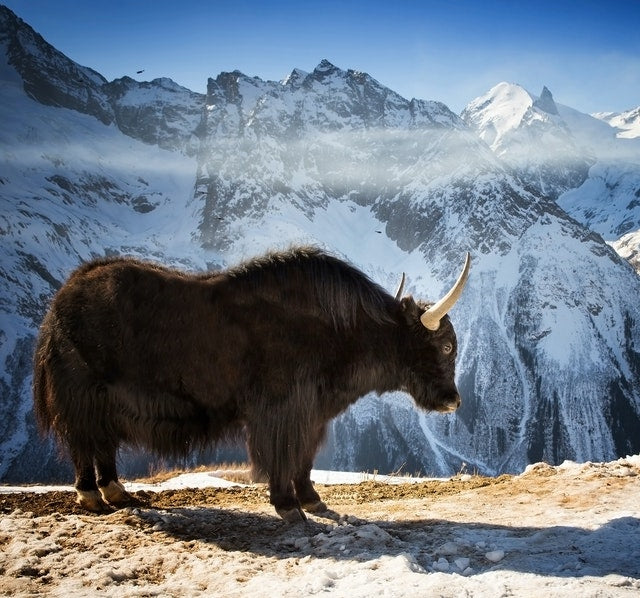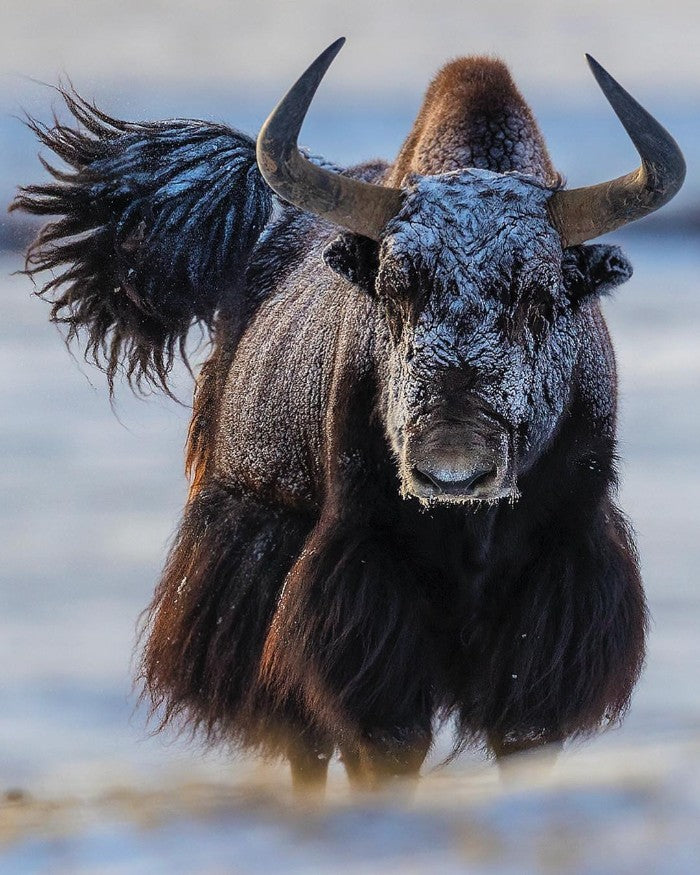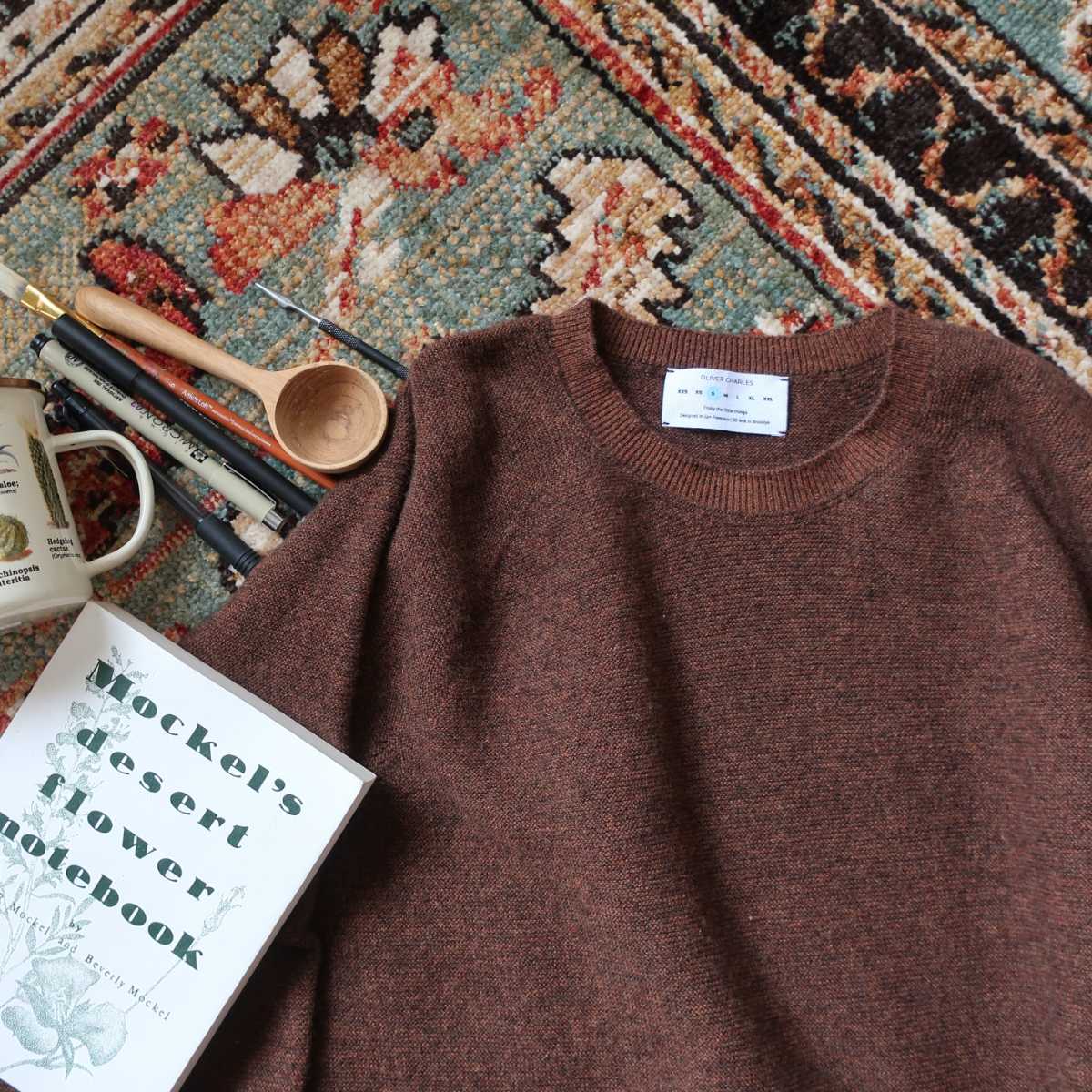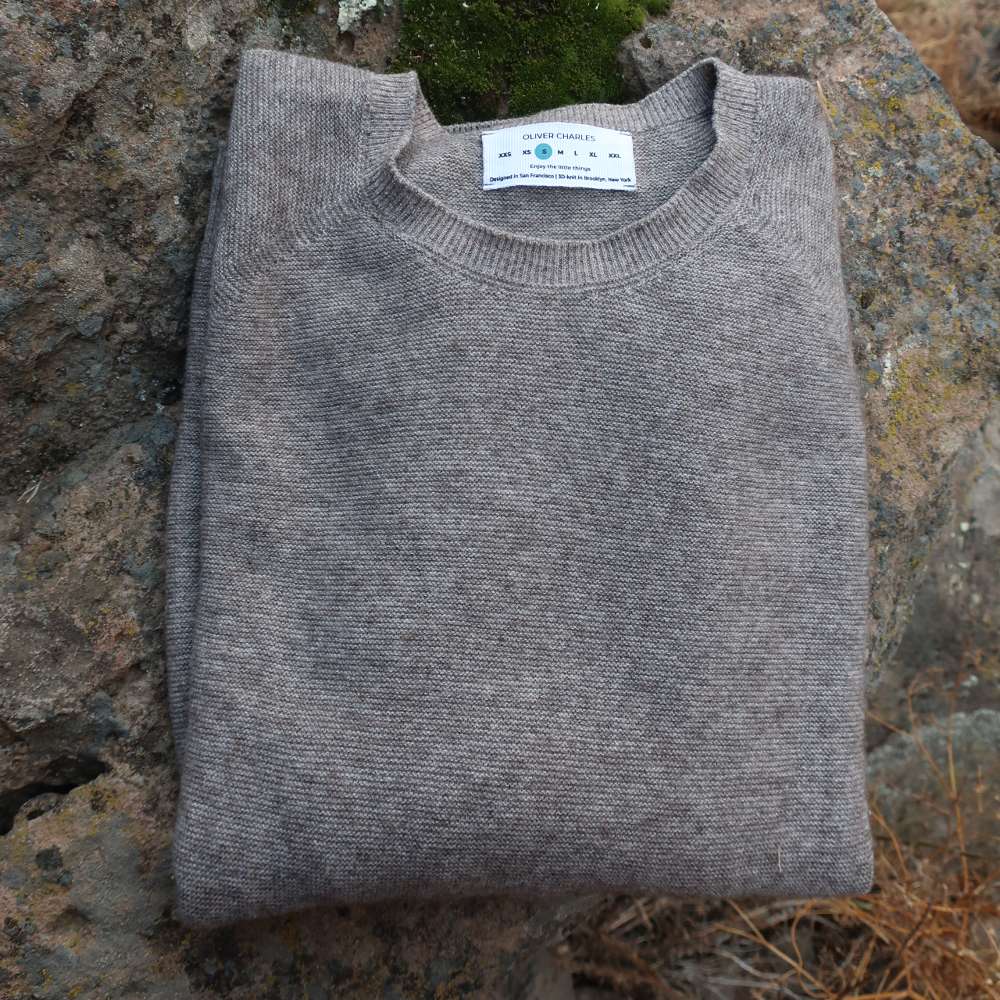What's Khullu And Why Is It Better Than Cashmere?
Yak wool is soft like cashmere, easy to care for unlike cashmere, plus it’s far more sustainable.
February 24, 2022
By Oliver Charles
Is Yak Wool The Same As Cashmere?
No, while Yak Wool and Cashmere are similar types of wool they come from two very different animals.
Yak Wool, believe it or not, comes from Yaks. While all yaks produce wool, the wool we use for sweaters comes from Tibetan yaks.
Cashmere on the other hand comes from a number of different goat breeds descendent from the Himalayan region of Ladakh, more broadly known as the Kashmir region.
In this post, we take a look at the unparalleled down fiber that yak naturally shed each spring. Yak wool, AKA “khullu” is not only a cashmere alternative because it’s similarly soft and comfy to wear all the time.
Khullu is also considered an alternative because it’s more sustainable, breathable, durable, and warmer than cashmere.
To understand why khullu is the world's best alternative to cashmere, we need to investigate where the materials come from.

Is Yak Wool (Khullu) Better Than Cashmere?
When we first started working on Oliver Charles, we built a massive curation of articles, scientific journals, and passages all-around materials.
We were set on making our sweaters out of soft, long-lasting, high-performing natural fibers from animals or plants that are gentle on the earth.
Cashmere was a top contender, but after learning about its negative impact on the environment, we decided to search for an alternative.
Here’s a small window into the furry friend that inspired the creation of our crew neck sweater. Drum roll 🥁… Ranging from 3 to 5 feet at the shoulder, 7 feet tall, and upwards of 2000 pounds, the mighty yak is a large bovine with a tan to a grayish-brown fur coat.
Yak's long oxlike face has bands of contrasting color, and although it can be shaggy, its hair is not as wooly as that of sheep. One long pair of horns grows atop its head, curving forward and downward.

Quick Facts About Yaks
Yaks are indigenous to the Himalayas, the Tibetan Plateau, and the mountains of Central Asia. Although, they can be found in many other parts of the world, including North America.
Over thousands of years, yaks have evolved to survive and thrive in the unforgiving high-altitude climate of the Himalayas. Yaks can live between 10,000 and 15,000 feet above sea level making them the highest-dwelling wool-bearing mammals in the world (source).
Because yak can thrive at high elevations, they are essential for humans who’ve maintained a lifestyle in the mountains.
Not only can yak help plow fields or carry essential supplies to remote communities, but they also shed both strong, coarse guard fibers and soft insulating down fibers in the spring.
Our focus is on down fibers AKA “khullu” to make our crew neck sweaters. However, guard fibers are equally important because they provide a durable material that can be woven into rope and canvas shelter.

Quick Facts about Cashmere
The vast majority of Cashmere producing goats are located in inner Mongolia. The country produces a third of the global supply of cashmere.
There is no such thing as a pure breed cashmere goat, in fact, there are about 20 different cashmere producing breeds living around the world. However, there are 4 overarching breeds responsible for the majority of wool found in clothing.
They include the Pashmina Goat, The Australian Cashmere Goat, Inner Mongolia Cashmere Goat, and the Chinese Cashmere Goat.
Since there are so many different breeds of goat that contribute to cashmere production, fibers are graded to ensure consistency.
Grade C cashmere is the lowest quality, measuring around 30 microns (µm) in width per cashmere hair. Grade B cashmere is intermediate, around 18-19µm in width per hair. Grade A cashmere is the finest and also most expensive going as low as 14µm in width per hair.
For reference, human hair has an average diameter of 75µm.


Is Yak Wool Softer Than Cashmere?
One of the most important factors that affects the way wool feels is the fiber fineness. While a human hair has an average diameter of 75 microns (µm), the yak wool we use in our sweaters is ultra-fine at 17.5µm.
Wools that are generally considered "soft" have a fineness <20µm. Fibers considered for use in cashmere clothing fall somewhere in the range of 14-19µm... so it depends, but generally, khullu is as soft as cashmere.

What is The Softest Type of Wool?
The softest (and also rarest) wools in the world can even get as low as 11μm in the case of Vicuña. Similarly, Qiviut fiber from muskox is considered softer than cashmere coming in as fine as 13μm.

Is Yak Wool More Breathable Than Cashmere?
As the highest-dwelling wool-bearing mammals in the world, yak live through a considerable range of temperatures.
Their ability to both survive in -40° F winters and thrive in 90° F summers is highly dependent on the evolutionary abilities of their luxurious khullu fiber.
Over the centuries, yak have developed enhanced lung and red blood cell capacity. They’ve also developed crimps in their fibers. Crimps are natural "waves" in yak wool that trap air.
These dynamic air pockets insulate yak in extreme colds and wick vapor, cooling in extreme heat.
The thermoregulating properties of their fiber is important because yak have few sweat glands... This means that their wool has to do a lot of the heavy lifting in keeping their body temperature at a comfortable equilibrium.
Khullu allows for even lightweight sweaters to be surprisingly warm.

Is Yak Wool Stronger Than Cashmere?
The crimps in yak wool are akin to a molecular coil spring. The fibers naturally expand and contract according to their environment.
The crimps allow yak wool fibers to be stretched up to 50% of their length when wet / 30% when dry and still bounce back to their original shape when stress is released. The flexibility gained from wool crimps makes yak wool fiber more durable.
For instance, yak wool can be bent back on itself more than 30,000 times without breaking, compared to about 3,000 times for cotton and 2,000 times for silk (American Wool).
This incredible strength means that Yak is machine washable.
Cashmere on the other hand is very delicate, particularly when it’s wet. Wet Cashmere fibers do not retain their shape, hence why so many people shrink cashmere sweaters in the wash.
Because yak wool clothing is warm, breathable, durable, and easy to care for, it’s often considered the best material for base and mid-layers and adventure.

Is Yak Wool More Odor Resistant Than Cashmere?
All wool contains moisture-wicking properties and is naturally antimicrobial, including cashmere.
Yak Wool and Cashmere have a number of unique moisture management properties that allow them to isolate and resist bacterial build-up - the leading cause of odor.
The isolation of bacteria reduces odor to the point where unwashed wool has 66% less odor intensity than plastic-based fibers and 28% less than cotton fabrics (Woolmark).

Is Yak Wool Warmer Than Cashmere?
Khullu is some of the highest performing wool… we go as far as saying it’s the world's best wool.
This is largely due to the evolution of the fibers that help yak survive dark cold winters and sunny hot summers.
The more intense the environment of the wooly mammal, the more versatile and high performing the fibers will be.
Yak live at elevations of up to 15-20,000 ft while cashmere goats live at elevations of up to 10-15,000 ft. The environments yak roam are colder and more rugged than their goat peer, so it’s likely that the fiber is warmer.
What we do know from research is that yak wool is 30% warmer than sheep wool and nearly 2x more breathable than cashmere.
Properties Of Khullu Vs. Cashmere
| Khullu | Cashmere | |
|---|---|---|
| Hand Feel | 🏆 | 🏆 |
| Breathability | 🏆 | 🥈 |
| Durability | 🏆 | 🥈 |
| Antimicrobial | 🏆 | 🏆 |
| Warmth | 🏆 | 🥈 |
| Sustainability | 🏆 | 🥈 |
🏆 = Winner
🥈 = 2nd place
Is Cashmere Sustainable?
The short answer is no. Having said that when compared to synthetic fibers wool is regenerative and biodegradable.
Cashmere is luxurious and soft, and the fibers contain all the many amazing properties of wool.
Some consider their quality cashmere garments to be heirlooms or timeless staples in their closet.
However, cashmere, once a luxury, is now everywhere: from fast fashion brands to premium luxury labels.
What’s not so far-reaching, however, is the knowledge of the supply chain behind cashmere.
Cashmere fiber comes from goats that provide a small amount of usable fiber each year… it takes up to 3 goats to produce a sweater and 6 produce a jacket.
Due to the globally rising demand, fiber from cashmere goats has continued to be more lucrative than other wools, which has resulted in a shocking increase in the number of cashmere goats herded throughout China and Mongolia.
With cashmere garments selling for anywhere between $30 to >$1,000, and with herd numbers growing by nearly 5 million a year, the real “scarce” resource isn’t goats or their wool, but instead, it’s grasslands for grazing.
Cashmere goats have sharp hooves which cause them to trample grasslands and long tongues, which allow them to rip plants from their roots when snacking.
Consider the amount of cashmere that a single goat can shed each spring. The most productive goats will produce at most 250 grams of wool a year.
Due to their relatively low wool yield, for herders to collect competitive volumes, they need to have many goats, usually grazing within a small area.
Overgrazing stresses the natural ecological role goats play in the region, and as a result, 90% of Mongolia is currently at risk of turning into a barren desert (already linked to a 4° F rise in regional temperature).
Cashmere goats are already responsible for transforming 70% of Mongolia's grasslands into deserts.
The degradation of grasslands immediately impacts more than half of the population of Mongolia who relies on and has deep ties to the land.
Indirectly, the effect of overgrazing on climate change will create significant long-term consequences globally (dust storms, temperature increase, drought, etc.)

Is Yak Wool More Sustainable Than Cashmere?
Yak is considered one of the most sustainable wool-producing animals in the world. Unlike cashmere goats, yak are gentle grazing animals.
They live nomadically throughout the mountains and plateaus of Tibet grazing by only removing the top of plants instead of their whole root.
Gentle grazing allows for much fast regeneration of pastures and grasslands keeping the sacred plains of the Tibetan plateau from turning into deserts.
Additionally, Yaks yield a much larger quantity of fiber each year. For every 5 cashmere goats, you only need 1 yak.
Sustainability Of Khullu Vs. Cashmere
| Khullu | Cashmere | |
|---|---|---|
| Nomadic Herding | ✅ | ✅ |
| Gentle Grazing | ✅ | ❌ |
| Viable Herd Size | ✅ | ❌ |
| High Fiber Yield
| ✅ | ❌ |
| Cruelty-Free | ✅ | ✅ |
| Machine Wash | ✅ | ❌ |
The Best Cashmere Alternative
Many materials used in the fashion industry have gained a mixed reputation over the last decade.
It’s true that synthetic plastic fibers are the worst polluters.
And as you read above, it’s true that cashmere goats are over-herded to meet a fast fashion level of demand and overgraze.
However, unlike synthetics, plant and wool-based materials aren’t inherently bad. In both categories there are sustainable alternatives.
For example, when looking at plant materials, Tencel is far more sustainable than Viscose and Modal. When looking at wool, khullu is a sustainable alternative to cashmere.
When looking at the materials in the clothes you order and wear, consider where they come from, how they material is produced, the impact of the materials on the Earth, and what is currently being done to allow the global demand for a material to exist without compromising sustainability.
In the case of yak wool, organizations are working with herders to scale their herds in a healthy manner.
Photo Credits:
- David W Smith Photography
- A Yak or 2 Ranch
- Jed Weingarten
- Star Yak Ranch
- Tara Magar
If you believe that every good wardrobe starts with owning less and owning better, consider buying yourself an OLIVER CHARLES sweater.
Shop NowCapsule Wardrobe: Beginner's Guide to Simplifying Your Closet
Capsule wardrobes made simple for beginners.
Read more1-Week Sweater Challenge: Sustainable Sweater For Any Occasion
How outfit repeating changed my life.
Read moreHow a Personal Uniform Fights Fast Fashion
I built a zero waste wardrobe by intertwining personal style and sustainability.
Read moreCapsule Wardrobe Sweater That Saves You Money
How having a capsule wardrobe benefits your budget.
Read more



